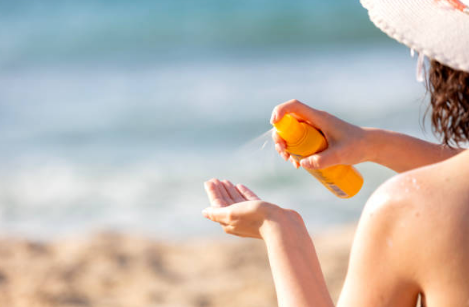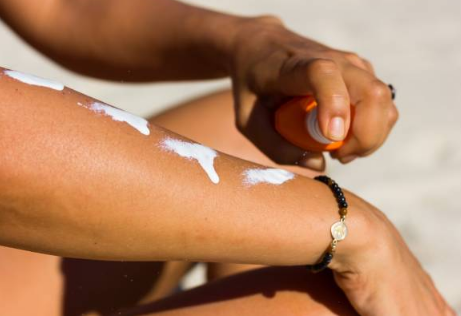If you’ve ever tried to apply sunscreen to a squirmy, wet kid at the pool—or reached around awkwardly to cover your own back—you probably understand the appeal of spray sunscreen.
Sunscreen is one of the most important ways to protect your skin from the sun’s harmful ultraviolet (UV) rays. Experts recommend using a broad-spectrum, water-resistant sunscreen with SPF 30 or higher, which helps guard against both UVA and UVB rays. While the two types of UV rays affect the skin differently, both can damage skin cells and increase the risk of skin cancer.
Spray sunscreen offers convenience, no doubt—especially for parents and people on the go—but it also comes with a few downsides when compared to traditional lotions and creams. And to work effectively, it has to be applied the right way.

Here are six common mistakes people make with spray sunscreen, and what you can do instead to keep your skin protected:
1. Not Using Enough
To fully cover exposed skin, adults need at least one ounce of sunscreen—about a shot glass full. With lotion, it’s easy to measure. With spray? Not so much.
Each major body part (arms, legs, chest, back, etc.) should be sprayed with enough product to look visibly shiny—about the size of a golf ball per area. After spraying, rub it in thoroughly to ensure even coverage.
You can also spray it directly into your hand and then apply it to your skin. This gives you more control and makes it easier to see how much product you’re actually using.
Mineral spray sunscreens—which physically block UV rays rather than absorbing them—can also help you visually see your coverage. These tend to look whiter or thicker when applied, which is actually a good thing. You’ll clearly see what’s covered and what’s not.
A good rule of thumb: hold the bottle a few inches from the skin, spray each area for at least six seconds, then rub it in. A quick spritz from a foot away won’t cut it.
2. Spraying in the Wrong Conditions
Spray sunscreen should always be used outdoors, never in small enclosed spaces like bathrooms or cars. These products release tiny particles into the air, which can irritate your eyes, throat, or lungs—especially if there’s no proper ventilation.
Also, spraying on a windy beach or moving boat? Most of that product is blowing away—not landing on your skin.
Instead, find a sheltered outdoor spot, like a porch or behind a windbreak. You can also spray into your hands and apply from there. And when it’s especially breezy? Opt for lotion or cream instead.
3. Skipping the Rub-In
A common myth: spray sunscreen means no mess, no hands. But that’s not how it works.
Even if you’ve sprayed generously, you still need to rub it in to ensure an even layer. If you don’t, you’re likely left with patchy coverage—and inconsistent protection.
Sunscreen only works when it forms a uniform layer on your skin, so take the extra few seconds to smooth it out.
4. Not Layering
Depending on the weather, your activity, and how long you’ll be outside, one layer of spray sunscreen may not be enough.
While spray is great for on-the-go touch-ups, it’s not always reliable for base protection since it often applies thin and unevenly. That’s why many dermatologists recommend starting with a lotion or cream first, then using a spray for reapplication. Sunscreen sticks are also great for quick touch-ups.

5. Not Reapplying Often Enough
Reapply every two hours, or immediately after swimming or sweating. Even “water-resistant” sunscreens don’t last forever—none of them are completely waterproof.
Yes, this applies even if you’re using SPF 50+. Higher SPF numbers can give people a false sense of security, but protection still fades with time, sweat, and sun exposure. SPF above 50 offers only a tiny increase in protection, so don’t count on it lasting longer.
Pro tip: Set a timer on your phone to remind you to reapply every two hours.
6. Using Expired or Old Sunscreen
Still holding onto that half-used can from last summer? Toss it.
Sunscreen loses potency over time as active ingredients break down, especially when it’s been exposed to heat (like sitting in a hot car). That means it won’t provide the protection you think it does.
After a day outdoors, bring your sunscreen inside instead of leaving it in the car or garage. As a general rule, treat each season or trip as a reason to start fresh with new sunscreen.
Bottom Line:
Spray sunscreen can be a lifesaver for quick and easy application—but only if you use it right. Apply generously, rub it in, reapply often, and don’t use expired products. With just a few extra steps, you can enjoy the sun safely and protect your skin for the long run.